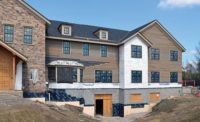As homeowners, facilities managers and building owners become more conscious of the need to conserve natural resources and protect structures—while also maintaining indoor air quality—air and vapor barriers will continue to play an important role. While each type of barrier has a unique strategic function, some lingering confusion and misperceptions regarding applications and specifications continue to exist.
Air Barriers: Control
An air barrier is designed to encase a structure on a continuous level to keep uncontrolled air from entering into—or escaping from—the building envelope. Air barriers are available in a variety of materials and may serve multiple purposes. A breathable membrane is common and is often referred to as a wrap. While popular, these types of barriers can be susceptible to punctures during installation. Peel and stick membrane, as well as airtight drywall and oriented strand board, also may be used.
Air barriers aid in controlling energy costs while helping to seal openings to limit pollutants, insects, and other pests from penetrating walls. Air barriers can and should be, installed throughout the wall assembly. In fact, the use of more than a single air barrier is an acceptable practice. Consider how layering clothing helps to maintain body temperature. Similarly, multiple air barriers reinforce each layer’s effectiveness in construction. Any material that has an air permeance that is not greater than 0.02 L/(s·m²) at a pressure difference of 75 Pa (0.004 cfm/ft² at a pressure difference of 1.56 lbs./ft²) when tested in accordance with ASTM E 2178, is considered an air barrier material.
While air barriers can be installed in numerous positions throughout a wall assembly, it is reasonable to expect that a single/initial barrier may allow for some minimal gaps or openings. As such, installing a second—or even a third barrier—will help to further reduce unwanted airflow. The Institute for Research in Construction and the National Research Council consider the following five requirements essential for an effective air barrier:
- Continuous coverage (no cracks, gaps, or openings)
- Impermeable to the leakage of air
- Rigidity (supported in both directions from air pressure)
- Durability (the air barrier should be engineered to last the life of the structure)
- Repairability (ease of access should a repair be required)
Vapor Barriers: Moisture Reduction
A vapor barrier serves to reduce the amount of water vapor—based upon the pressure level—that can pass through walls, floors, ceilings, or roof assemblies. Vapor barriers typically are constructed as a coating or thin film, to allow for flexibility.
A vapor barrier’s primary function is the remediation of water particles rather than air movement control. Moisture penetration can cause severe damage to a building’s components and contribute to adverse health effects for occupants due to the potential for growth of mold and mildew. In colder regions, it is recommended that the moisture barrier be installed inside the face of wall studs. Alternatively, in warmer or wet climates, the barrier is most frequently installed on the structure’s exterior.
Vapor barriers are tested using a materials moisture vapor transmission rate. Permeability is reported in perms. The test method for determining the water vapor permeance of any building material is ASTM E96 (Standard Test Methods for Water Vapor Transmission of Materials). The test measures diffusion using two possible means—the dry cup (desiccant) method and the wet cup (water) method. Therefore, the lower the perm rating, the more successful the barrier will be at keeping moisture at bay.
The Complete Approach
Some innovative solutions are available that combine the best of both types of protection. A good example is the use of polyamide film. This film changes its permeability with ambient humidity conditions while providing a continuous air seal. It remains tight in the winter—when humidity is lower—to prevent moisture from entering the wall cavity. And during the summer, permeability increases to facilitate moisture escape. Other solutions include continuous polystyrene, which also functions as insulation. What’s more, some house wraps can provide both air and vapor protection.
It is imperative that those specifying air and vapor barriers understand the unilateral importance of mitigating mold and mildew while providing energy-efficient structures. A key factor to building sustainable, durable, efficient buildings that provide optimum indoor quality is moisture management.
When choosing any of these solutions, it is vital to understand how resilient, adaptable, and durable the complete system is so that it will ensure high-quality performance over the life of the building.
Moving Forward
As acute and sudden temperature shifts and extreme weather events become more commonplace, specifying high-performance barriers will become even more critical. Fortunately, building scientists and manufacturers are responding by increasing the development of robust, efficient, and multiple-purpose building materials that facilitate better control of both air and moisture.





Report Abusive Comment